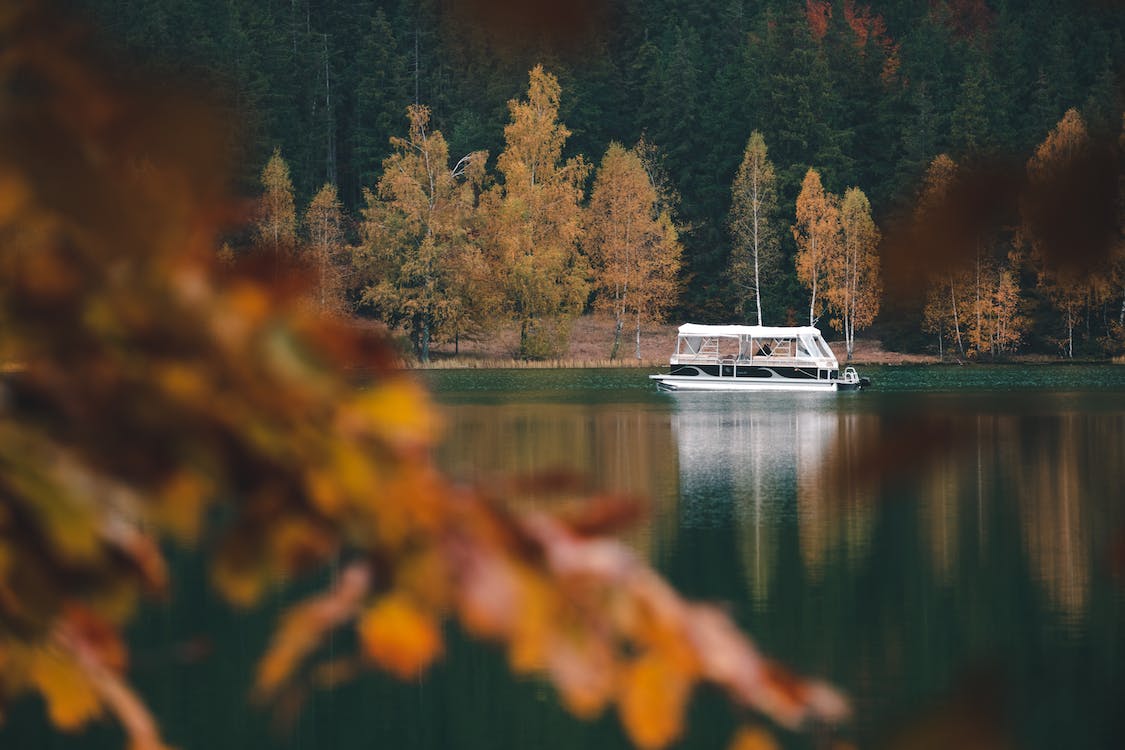From Sun to Snow: A Complete Guide to Prepping Your Boat for the Cold Season

As the days of summer fade and the cool air of fall sets in, it becomes vital for boat owners to think about getting their boats ready for the colder months. But why is this preparation so important? Here are some key reasons:
- Protection from Harsh Weather: Fall and winter often bring unpredictable and potentially harmful weather. Your boat needs the right prep to withstand strong winds, freezing temperatures, or heavy snow and rain.
- Prevention of Damage: Proper preparation stops problems like freezing water cracks, mold from moisture, and wear and tear from prolonged exposure to harsh conditions.
- Avoidance of Costly Repairs: Taking care of potential issues now means avoiding bigger, pricier problems later. A neglected boat can lead to significant damages and repair costs.
- Extend the Lifespan of Your Boat: Regular maintenance, especially as seasons change, keeps your boat in tip-top shape for longer, ensuring it lasts and maintains a good resale value.
- Safety: A well-prepped boat is a safe boat. Ensuring your vessel is ready for the colder months means you're prioritizing the safety of everyone on board.
- Ease of Use in the Next Season: When the next boating season rolls around, you'll be glad you took the time to prepare. A well-maintained boat is quicker to get back on the water, letting you make the most of the season.
Whether you're planning on sailing through the fall or storing your boat for winter, it's essential to take these steps. Keeping your boat in the best condition now ensures smoother sailing later on.
1. Give Your Boat a Thorough Check-Up
Just like you'd give your car a good look-over before a long trip, you need to do the same for your boat as the seasons change. This is about spotting any little issues now so they don't become big problems later. Here's a step-by-step guide to help you check your boat:
Boat Body and Bottom
Start by looking at the outer part of your boat:
- Body: Walk around your boat and look closely at the surface. Do you see any scratches, dents, or marks? If something doesn't look right, take note of it. Even small cracks can be a sign that there's more damage hidden underneath.
- Bottom: This is the part that's always in the water, so it's super important. Check for any signs of damage, like holes or cracks. If you've hit something in the water recently, this is where you might see the effects.
Motor and Moving Parts
Your boat's motor is its heart. It needs to be in top shape to keep you moving safely on the water:
- Motor Check: Take a look at the motor. Is there any rust or wear? If there are any parts that look old or broken, you might need to replace them.
- Moving Parts: These are the bits that are always moving when you're on the water, like propellers. They should turn smoothly without making any weird noises. If they're stuck or noisy, they might need some attention.
Sails (For Sailboats)
If you have a sailboat, your sails are super important. They catch the wind and push you along, so they need to be in great condition:
- Checking Sails: Spread out the sails and look at every inch. What you're looking for are any tears or holes. Even small tears can grow bigger with the wind's force, so if you spot anything, it's a good idea to get it fixed.
Remember, giving your boat this check-up doesn't just keep the boat happy; it keeps you safe too. So, take your time and be thorough. If anything seems off or you're unsure about something, it's always a good idea to ask a professional for help.
2. Time for a Thorough Clean
Keeping your boat clean isn't just about making it look good. Dirt, grime, and especially sea salt can damage your boat over time. Think of it like taking care of your car or your home - regular cleaning helps things last longer and work better. Let's break down the cleaning steps:
Start with a Good Wash
You'd be surprised how much dirt and salt can build up on your boat. These can cause damage if they're not washed off:
- Use the Right Soap: Just like you wouldn't use dish soap to wash your hair, make sure you're using soap designed for boats. It's made to clean without damaging the boat's surface.
- Rinse Well: After soaping, rinse off every bit of soap. Leftover soap can leave marks or damage the finish.
Protect the Outside
Now that your boat is clean, let's protect it:
- Apply a Protective Coat: Think of this as sunscreen for your boat. A protective coating or wax helps shield the boat from the sun and keeps dirt and salt from sticking. It also gives your boat a nice shine!
Don't Forget the Inside
You spend a lot of time inside your boat, so let's make sure it's clean and comfortable:
- Clean Seats: Wipe down any seats. If they're fabric, consider vacuuming them. For leather or vinyl seats, a gentle cleaner will help remove any dirt and keep them looking good.
- Floors and Compartments: Sweep or vacuum the floors, and make sure to clean out any compartments or storage areas. This helps prevent mold or mildew from forming, especially in damp environments.
Remember, a clean boat isn't just about pride in appearance; it's about maintaining its value and ensuring its longevity. Taking a bit of time now can save you a lot of time and money down the road.
3. Check All Your Boat's Equipment
Just like you'd check the batteries in your home's smoke detector, you need to make sure everything on your boat is working properly. It's not just about convenience—it's about safety. Here's a detailed look at what you should check:
Navigation and Communication Tools
Getting lost at sea isn't fun. And if there's an emergency, you need to call for help. So:
- GPS Check: Turn on your GPS and make sure it's picking up a signal and showing your correct location. If it's not, you might need to check the connection or see if it needs an update.
- Radio Testing: Try out your radios. Can you pick up a signal? If you have a two-way radio, get a friend to check if they can hear you clearly.
Powering Up
Without power, a lot of your boat's essential features won't work. Let's make sure you won't run out of juice:
- Battery Check: Look at your boat's batteries. Are they fully charged? If they're old or don't hold a charge well, consider replacing them before your next trip.
Connections Matter
All the equipment in the world won't help if it's not connected right:
- Inspect for Rust: Check where your devices plug in or connect. If you see any rust or corrosion, clean it off. Rust can stop your gadgets from working and might even damage them.
By spending a little time checking everything now, you can save yourself from bigger problems (and potential dangers) later on. Safe boating means working equipment, so don't skip this step!
4. Take Care of Your Boat's Engine
Think of your boat's engine like its heartbeat. Just as we need to care for our heart by eating right and exercising, your boat's engine also needs some love and attention to keep running smoothly. Here's a simple guide to keep your boat's heart – I mean, engine – happy and healthy:
Oil Change: Just Like at the Doctor’s
Imagine going years without a health check-up. Doesn't sound too good, right? Your boat feels the same way about its oil. Here’s what to do:
- Change the Oil: Fresh oil helps your engine run smoothly. It's like giving it a refreshing drink.
- Switch Out the Oil Filter: This acts like a net, catching all the nasty stuff. Over time, it gets full. So, change it when you change the oil.
Fuel System: The Boat’s Food
Your boat 'eats' fuel. Just like we want clean, good quality food, your boat wants clean fuel. Let's make sure it gets that:
- Look for Leaks: A quick look-over can show you if there's any fuel dripping or leaking. That’s a sign something needs fixing.
- Use a Fuel Stabilizer: If your boat is going on a 'diet' and won’t be used for a while, add some stabilizer to the fuel. It keeps the fuel fresh, so your boat's ready to go when you are.
Belts and Hoses: The Boat's Veins and Arteries
Just like we have veins carrying blood around our body, boats have belts and hoses to transport fluids:
- Check 'Em Out: Look at the belts and hoses. Do they look old or worn out? Are they cracked? If yes, it's time for new ones.
- Replace if Needed: Don't wait for a belt to break or a hose to leak. If they look tired, give them a rest and get new ones.
Maintaining your boat's engine might sound like a lot of work, but just like looking after our health, a little effort now can save a lot of trouble later. So, give your boat the care it deserves, and it'll thank you with smooth rides!
5. Empty Out and Safeguard
Imagine leaving a water bottle outside during winter. What happens? It freezes and can even burst! The same can happen to the water in parts of your boat. When water freezes, it expands and can break things. So, before it gets too cold, we need to empty out the water and keep the boat safe from freezing damage. Here's how:
Empty Out the Water
Just like emptying a cup before you put it away, we need to empty the water out of some parts of the boat:
- Engine: This is the boat's heart. We don't want any water lingering around there. Make sure to drain it out.
- Cooling System: This helps keep the boat's engine from getting too hot. It can have water inside, so give it a good drain.
- Bilge: This is like the boat's basement. Sometimes water collects there. Use a bilge pump or bucket to get it out.
Antifreeze: The Boat's Winter Coat
Antifreeze is like a cozy winter coat for your boat's engine. It helps keep things from freezing:
- Check Levels: Look to see how much antifreeze is in the boat. If it's low, you'll need to add some more.
- Top Up: If the antifreeze is low, fill it up. But make sure you're using the right kind! It should be marine-grade, which means it's safe for boats, and match your engine type.
With these steps, you're giving your boat a better chance to stay safe and sound during the chilly months. Think of it as tucking your boat into a warm bed for the winter!
6. Keep Safety on Top
Safety isn't just a word; it's a lifesaver, especially when you're out on the water. Just as you'd buckle up in a car or wear a helmet on a bike, you need to make sure your boat's safety tools are in tip-top shape. Here's how:
Check Your Life-Saving Gear
These items can make a huge difference in emergencies:
- Life Jackets: Make sure they're in good shape. No rips, tears, or broken straps. Every person on the boat should have one that fits well.
- Fire Extinguishers: Look at the gauge to ensure they're full and ready to use. They're your first defense if a fire starts.
- Flares: These are like bright torches that signal for help. Check their expiration dates; old ones might not work.
- First Aid Kits: Open them up and see if anything's missing or expired. From band-aids to pain relievers, it should have essentials for minor injuries.
Let There Be Light!
Imagine being out in the dark with no lights. Sounds scary, right? Lights guide your path and signal to others where you are:
- Navigation Lights: They're like turn signals and headlights for boats. Make sure they're shining bright.
- Inside Lights: Ensure all the bulbs in the cabin and other interior spaces work. You wouldn’t want to fumble around in the dark.
Remember, a safe boat trip isn’t just about having fun but making sure you and everyone on board is protected. Keep your safety gear in check and enjoy peace of mind every time you set sail!
7. Thinking of Parking Your Boat? Here's How:
Winter is coming, and if you're not planning on sailing through the colder months, you need to figure out where to keep your boat safe. Let's break down your options:
Storing Inside (Like a Big Boat Garage)
This is like giving your boat a warm room during cold times:
- Protection: Inside storage means your boat is safe from rain, snow, and strong winds. It won't get wet, dirty, or damaged from bad weather.
- Price: This option can be a bit costly. Think of it as renting a room for your boat. But it's worth it if you want the best protection.
Storing Outside (Under the Sky)
It's like parking in an open space, but you have to make sure your boat stays cozy:
- Cover Up: Just as you wear a jacket in the cold, your boat needs one too. A thick, high-quality boat cover or tarp will keep it dry and clean.
- Budget-Friendly: Keeping your boat outside can save you money. It's usually cheaper than inside storage.
Storing on Water (Like Floating Parking)
Some people like to keep their boat in the water, even when not using it. If that's you, here's what to keep in mind:
- Check the Ropes: The ropes (or "lines") that tie your boat to the dock should be strong and secure. You don’t want your boat floating away!
- Protective Gear: Fenders are like big cushions for boats. They prevent scratches and dents when the boat rocks or bumps into the dock.
- Water Out: The bilge pump removes unwanted water from the boat. Make sure it's working right, so your boat doesn't get filled up with rain or splashed water.
No matter where you decide to store your boat, the main thing is to ensure it's safe and ready for your next adventure when the warmer days return!
In conclusion, as the seasons shift, ensuring that your boat is well-prepared and safeguarded is not just about prolonging its lifespan, but also about guaranteeing safety and optimizing its performance for the next season. The meticulous steps and checks mentioned above will help you sail confidently, knowing your boat is in top-notch condition.
If you're looking for professional advice, parts, or perhaps considering upgrading your boat, consider visiting the Atlantis Showroom. With a vast collection of boats and accessories, and a knowledgeable team, it's your one-stop destination for all things boating.
Check out our website at Atlantis Showroom!- Choosing a selection results in a full page refresh.










































